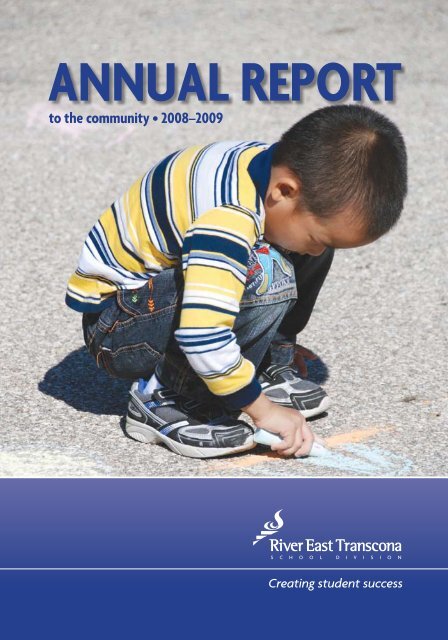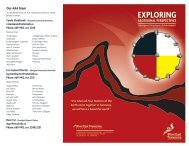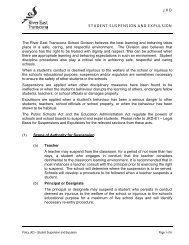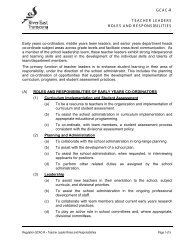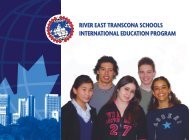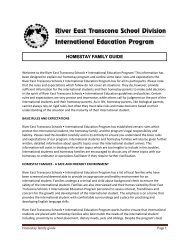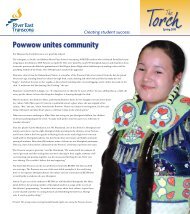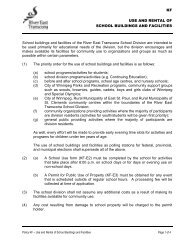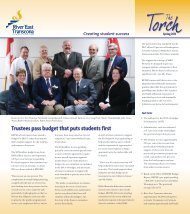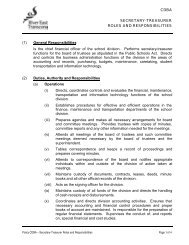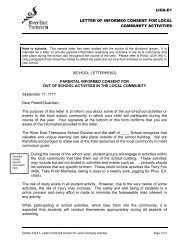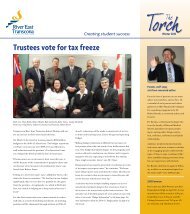2008-09 - Retsd.mb.ca
2008-09 - Retsd.mb.ca
2008-09 - Retsd.mb.ca
You also want an ePaper? Increase the reach of your titles
YUMPU automatically turns print PDFs into web optimized ePapers that Google loves.
ANNUAL REPORT<br />
to the community • <strong>2008</strong>–20<strong>09</strong><br />
Creating student success
greetings<br />
PURPOSE<br />
The River East<br />
Transcona School<br />
Division exists to<br />
edu<strong>ca</strong>te students<br />
to be inspired,<br />
skilled, responsible<br />
citizens.<br />
VISION<br />
The River East<br />
Transcona School<br />
Division will be<br />
forward-looking,<br />
innovative and<br />
service-oriented,<br />
offering superior,<br />
comprehensive<br />
programming<br />
to meet the<br />
emerging needs<br />
of our students<br />
and community.<br />
MISSION<br />
To fulfil our purpose<br />
and in our<br />
journey toward our<br />
vision, the River<br />
East Transcona<br />
School Division<br />
is committed to<br />
provide:<br />
Relevant, progressive<br />
edu<strong>ca</strong>tional<br />
programming and<br />
supportive services<br />
in a safe, stimulating<br />
learning environment.<br />
On behalf of the board of trustees, I present River East<br />
Transcona School Division’s <strong>2008</strong>–<strong>09</strong> annual report to<br />
the community. It <strong>ca</strong>ptures just some of the stories that<br />
demonstrate how we work to fulfil our purpose—to edu<strong>ca</strong>te<br />
students to be inspired, skilled, responsible citizens.<br />
Our divisional priorities act as a guide and are reflected<br />
in the stories you will read in this report. They highlight<br />
the ways we are nurturing student success, instilling an<br />
attitude of <strong>ca</strong>re and respect for the community and world, introducing new technology<br />
to advance edu<strong>ca</strong>tion and business practices, and building partnerships in<br />
the community.<br />
As a school board, we are proud to be the guardians of these programs, services<br />
and initiatives, and pleased to have this opportunity to tell you about some of<br />
them.<br />
Robert Fraser<br />
Chair, Board of Trustees <strong>2008</strong>–<strong>09</strong><br />
I am pleased to provide you with this opportunity to<br />
learn more about some of the new projects, ongoing<br />
initiatives and valued staff and students that make up<br />
River East Transcona School Division.<br />
Each year, retsd covers a lot of ground, fulfilling the<br />
individual and widely varying needs of its students,<br />
rising to meet the inherent challenges and celebrating<br />
our many successes. In this report, you will find stories<br />
that demonstrate how we are working toward ever-present objectives—providing<br />
challenging a<strong>ca</strong>demic programming, nurturing our students’ commitment to<br />
citizenship, and helping those who need extra supports feel e<strong>mb</strong>raced by the<br />
edu<strong>ca</strong>tional community.<br />
This has been another successful year for River East Transcona School Division<br />
and this report provides just a taste of the important work being done by our staff<br />
to inspire students to work, <strong>ca</strong>re, give, dream and achieve.<br />
Dennis Pottage<br />
Superintendent/CEO<br />
divisional priorities 20<strong>09</strong>–10<br />
1. Strengthen assessment practices to inform teaching and enhance learning.<br />
2. Create and enhance safe, respectful and inclusive cultures.<br />
3. Enhance student performance through information and communi<strong>ca</strong>tion<br />
technologies.<br />
4. Enrich edu<strong>ca</strong>tional opportunities for students through purposeful<br />
connections between the division and its community.
FINANCIAL details<br />
River East Transcona School Division is responsible for providing sufficient<br />
resources and skilled professional and support staff to edu<strong>ca</strong>te, guide and serve<br />
the needs of our students so they <strong>ca</strong>n learn and progress to the fullest extent<br />
possible.<br />
The following breakdown of operating expenditures provides a detailed look<br />
into how money is distributed to key areas. It illustrates that the focus of our expenditures<br />
continues to be on preserving essential programming and providing<br />
resources to instructional activities.<br />
RETSD <strong>2008</strong>–<strong>09</strong> Operating Budget<br />
Instructional Programs DOLLARS %<br />
FINANCE FACTS<br />
The following is a summary<br />
of income sources for the<br />
<strong>2008</strong>–<strong>09</strong> school year:<br />
Provincial program funding<br />
54.7%<br />
Lo<strong>ca</strong>l special levy<br />
32.1%<br />
Edu<strong>ca</strong>tion property tax credit<br />
10.8%<br />
Other provincial sources<br />
1.7%<br />
Non-provincial sources<br />
0.7%<br />
Regular Instruction 87,844,430 57.6<br />
Student Support Services 27,202,152 17.9<br />
Instruction & Other Support Services 6,917,144 4.5<br />
The following is a summary<br />
of expenditures for the<br />
<strong>2008</strong>–<strong>09</strong> school year:<br />
Total budget for instructional programs 121,963,726 80<br />
Support Services DOLLARS %<br />
Division Administration 4,399,630 2.9<br />
Community Edu<strong>ca</strong>tion & Services 572,000 0.4<br />
Transportation of Pupils 2,855,100 1.9<br />
Operations & Maintenance 18,583,690 12.2<br />
Payroll Tax & Interest 2,632,000 1.7<br />
Salaries and benefits<br />
83.6%<br />
Services and utilities<br />
8.2%<br />
Supplies, materials and<br />
equipment<br />
5.4%<br />
Interest, payroll tax and<br />
Schools of Choice<br />
1.9%<br />
Capital expenditures<br />
0.9%<br />
Capital Expenditures 1,471,700 0.9<br />
Total budget for support services 30,514,120 20<br />
Grand total • all areas 152,477,846 100
STUDENT SUCCESS<br />
Head start on apprenticeships<br />
By continuing to provide quality vo<strong>ca</strong>tional programs, retsd is doing its part to meet the growing demand<br />
for workers trained in techni<strong>ca</strong>l-vo<strong>ca</strong>tional professions.<br />
The division offers 12 vo<strong>ca</strong>tional programs: cosmetology, and health and child <strong>ca</strong>re at Miles Macdonell<br />
Collegiate; power mechanics, metals and aerospace technology, building construction, and fashion<br />
technology and design at Murdoch MacKay Collegiate; and graphic arts, photography, autobody repair,<br />
building construction, food services, electricity, power mechanics, refrigeration and air conditioning and<br />
cosmetology at Kildonan East Collegiate. To complete a vo<strong>ca</strong>tional program, students must take at least<br />
four courses from the program per year in grades 11 and 12.<br />
Students in five of these vo<strong>ca</strong>tional programs <strong>ca</strong>n earn credits toward apprenticeship while still in high<br />
school. This opportunity is made possible through a partnership with the Province of Manitoba’s techni<strong>ca</strong>l<br />
vo<strong>ca</strong>tional initiative.<br />
Through the initiative, cosmetology, power mechanics, food services, electricity, and metals and aerospace<br />
either have articulation agreements or fall under the senior years apprenticeship option. These arrangements<br />
mean the training students receive in their high school programs counts toward apprenticeship<br />
upon graduation. To qualify for the credits associated with these agreements, students must maintain a<br />
minimum 70 per cent average in each course.<br />
For high schools to secure the agreements, strict criteria must be met and approved by the Manitoba<br />
Apprenticeship Branch. For example, instructors must be journeypersons, or have Red Seal status or<br />
other advanced qualifi<strong>ca</strong>tions. The branch also does a thorough review of the program curriculum and<br />
does a site visit to ensure the training facility and equipment meet set standards. To ensure its students<br />
are trained on the best and latest equipment, retsd regularly applies for additional upgrading support<br />
through the techni<strong>ca</strong>l vo<strong>ca</strong>tional initiative.<br />
2
ENRICHED PROGRAMS BENEFIT MANY<br />
River East Transcona School Division provides programming to meet a wide<br />
variety of interests and strengths. As well as vo<strong>ca</strong>tional, a<strong>ca</strong>demic and special<br />
needs programming, the division offers additional a<strong>ca</strong>demic challenges through<br />
the International Bac<strong>ca</strong>laureate (ib) and Advanced Placement (ap) programs.<br />
The ib program is offered at Miles Macdonell Collegiate, one of only five high<br />
schools in Winnipeg to have the program, and ap is offered at Kildonan East,<br />
Murdoch MacKay and River East Collegiates.<br />
Both ib and ap are internationally-recognized, offer enriched programming and<br />
are taught at first-year-university level, providing the opportunity to earn university<br />
credits while attending high school. Advance credits may give students a<br />
head start on their university edu<strong>ca</strong>tion and save on the tuition otherwise paid<br />
to take the courses. However, many students, despite having taken the university-equivalent<br />
courses, opt to take them again once attending university. They<br />
consider their ib or ap studies to be preparation that gives them an advantage<br />
in university, increasing their chances of earning a high grade point average in<br />
previously studied subjects.<br />
The ib diploma program requires students to take a minimum of six ib courses<br />
over two years. Students are assessed based on their final exams, and their<br />
performance on a 4,000-word research paper, a theory of knowledge course and<br />
150 hours of school and community service. In retsd, students <strong>ca</strong>n also opt<br />
for an ib certifi<strong>ca</strong>te, taking ib courses without the additional program requirements.<br />
Advenced Placement is similar to the ib certifi<strong>ca</strong>te, both offering accelerated<br />
programming. Students <strong>ca</strong>n take a full ib or ap course-load or one or two<br />
courses that focus on their key strengths. ap classes each culminate in a final<br />
exam that is the sole assessment tool for the course. Two of the restd schools<br />
offering ap also offer vo<strong>ca</strong>tional programs, providing students with the option<br />
of taking ap courses while learning a trade. Students choosing this path have<br />
an increased opportunity to get a job in their chosen field immediately following<br />
high school, allowing them to earn their tuition money while they continue<br />
their studies.<br />
Hundreds of retsd students take ap and ib courses each year, contradicting<br />
the common belief that ib and ap are designed for and <strong>ca</strong>ter to a small, elite<br />
group of students. Miles Macdonell reaches its ib <strong>ca</strong>pacity every year and has<br />
one of the largest ib programs in Winnipeg. In <strong>2008</strong>, 14 ib students scored in<br />
the top three per cent in the world on their exams, and over the past de<strong>ca</strong>de,<br />
more than 20 National AP Scholars have emerged from the division.<br />
FAST FACTS<br />
<strong>2008</strong>–<strong>09</strong> SCHOOL BOARD<br />
MEDAL WINNERS<br />
GOLD<br />
Matt Sans<strong>ca</strong>rtier • MMCI<br />
SILVER<br />
Chantal Dienstbier • CPET<br />
Michelle Perner • KEC<br />
David Thiessen • MMC<br />
Kyle Nemez • REC<br />
Jayce Van Alstyne • TCI<br />
20<strong>09</strong> STAFF AWARDS<br />
Sylvia Marshall received the<br />
Minister’s Award for Excellence<br />
in Teaching; Peter Brown was<br />
named one of Canada’s top<br />
technology teachers by the<br />
Canadian Council of Technicians<br />
and Technologists; Adair<br />
Morrison and Jim Hoddinott<br />
were honoured by then Lt.-<br />
Gov. John Harvard for their<br />
work in inclusive edu<strong>ca</strong>tion—<br />
Community Living-Manitoba<br />
also presented Hoddinott with<br />
the <strong>2008</strong> President’s Award<br />
in Inclusive Edu<strong>ca</strong>tion; and<br />
David Markham received the<br />
<strong>2008</strong>–<strong>09</strong> Physi<strong>ca</strong>l Edu<strong>ca</strong>tion<br />
Teaching Excellence Award<br />
from Physi<strong>ca</strong>l and Health<br />
Edu<strong>ca</strong>tion Canada.<br />
GRADUATION 20<strong>09</strong><br />
Regular 967<br />
Vo<strong>ca</strong>tional 116<br />
Dual diploma 94<br />
French Immersion 126<br />
Mature student 10<br />
Special 14<br />
Total 1327
CARING SCHOOLS<br />
SOCIAL RESPONSIBILITY INTEGRATED IN STUDIES<br />
River East Transcona School Division has a long history of branching out beyond reading, writing and<br />
arithmetic to integrate social responsibility as a key ingredient in its students’ edu<strong>ca</strong>tion. The growth of<br />
information-sharing and media has further heightened our schools’ awareness of both lo<strong>ca</strong>l and global<br />
issues. It has become common for our students to get involved in school-based efforts to effect positive<br />
change in their community and communities around the world.<br />
From early to senior years, a large nu<strong>mb</strong>er of retsd students have participated in poverty-awareness<br />
weeks, organized food drives, studied lo<strong>ca</strong>l poverty issues and volunteered at food banks. Many have<br />
been involved in the Empty Bowls project—designing and creating ceramic bowls, serving a simple meal<br />
of soup and bread to parents and the community, and raising thousands of dollars for Winnipeg Harvest.<br />
Other students have asse<strong>mb</strong>led relief kits for families around the world who have been traumatized by<br />
natural disasters and war. To fend off natural disaster lo<strong>ca</strong>lly, a nu<strong>mb</strong>er of our students volunteered to<br />
sandbag during the spring flood. A group of early and middle years students have taken on the responsibility<br />
of <strong>ca</strong>ring for the riparian habitat—the area between land and stream—at Bunn’s Creek Centennial<br />
Park. From one school to the next, fundraising projects thrive, whether for wells in Afri<strong>ca</strong> or for lo<strong>ca</strong>l<br />
organizations, such as Siloam Mission, Agape Table and The Winnipeg Humane Society.<br />
Some of these initiatives are undertaken by extracurricular student leadership groups, but a great<br />
nu<strong>mb</strong>er are <strong>ca</strong>rried out by an enthusiastic general student population who are also being edu<strong>ca</strong>ted about<br />
issues as diverse as child labour, fair trade, human trafficking and treaty rights. As more importance is<br />
placed on the cultivation of environmental and social awareness, ethics and cultural sensitivity in our<br />
students, connecting social responsibility to the curriculum has become fundamental.<br />
4
cREATING CITIZENS OF THE WORLD<br />
River East Transcona School Division’s purpose is “to edu<strong>ca</strong>te students to<br />
be inspired, skilled, responsible citizens.” To that end, while the division<br />
develops its students’ abilities in many subjects, it also strives to cultivate the<br />
ideals, knowledge and skills of good citizenship.<br />
In <strong>2008</strong>, three retsd schools—Collège Pierre-Elliott-Trudeau, Kildonan<br />
East Collegiate and Springfield Heights School—were recognized for their<br />
efforts by Manitoba Edu<strong>ca</strong>tion, Citizenship and Youth and awarded Innovation<br />
in Citizenship Edu<strong>ca</strong>tion grants. The grants provide funding of up to<br />
$1,000 to cover costs of a project related to issues such as civic responsibility,<br />
social justice, global concerns, human rights, environmental stewardship<br />
and the democratic process.<br />
Collège Pierre-Elliott-Trudeau is a participant in unesco’s Associated<br />
Schools Project Network. Its project goal was to connect all the school’s<br />
programs, activities and events with unesco’s four pillars of learning, which<br />
encourage awareness of world issues, active involvement in building solutions,<br />
development of attitudes and commitment to global citizenship, and<br />
respect for self and others. Students participated in an “urban plunge” to<br />
examine poverty in Winnipeg’s inner city, attended a conference on poverty<br />
issues, hosted a presentation about the food crisis in Haiti, and held an<br />
1,800-minute famine to fundraise for a Bolivian orphanage the school supports.<br />
At Kildonan East Collegiate, a group of 32 enterprising students, along<br />
with several teachers, have set a goal to raise $200,000 by June 2010 for<br />
humanitarian projects in Tanzania, East Afri<strong>ca</strong>. Half of the money will fund<br />
projects such as clean water initiatives and animal husbandry programs. The<br />
other half will support student travel to Tanzania upon graduation, to learn<br />
about and participate in the implementation of the projects. The group will<br />
have the opportunity to make a direct impact on the community and learn<br />
first-hand about human rights issues and another culture.<br />
Students from Springfield Heights School held a mock election, studied<br />
citizenship and active democracy, and learned about countries where there<br />
have been struggles for democratic rights. As well, an origami club was<br />
founded to promote peace and co-operation. Students in the club learned<br />
origami skills and then taught these skills to their peers. The students collaborated<br />
to create a 100-crane mobile that was exhibited at the Millennium<br />
Library and then sent to India to be displayed in an orphanage.<br />
FAST FACTS<br />
STUDENT RECOGNITION<br />
Congratulations to the<br />
following RETSD students<br />
who were recognized for<br />
their efforts in the realm of<br />
social responsibility:<br />
. . .<br />
Four Grade 11 students<br />
received the <strong>2008</strong> United<br />
Way community service<br />
award—David Ward-Nightingale<br />
of Collège Pierre-<br />
Elliott-Trudeau, Kendra<br />
Okrusko of Kildonan East<br />
Collegiate, Crystal Gladu<br />
of Murdoch MacKay Collegiate<br />
and Peter Espinola<br />
of Transcona Collegiate.<br />
. . .<br />
River East Collegiate student<br />
James Plamondon was<br />
chosen by the Winnipeg<br />
Police Service as the winner<br />
of a video contest for the<br />
Just Slow Down anti-speeding<br />
<strong>ca</strong>mpaign.<br />
. . .<br />
Maple Leaf School received<br />
the Mayor’s Volunteer Service<br />
Award in the Effective<br />
Use of Youth <strong>ca</strong>tegory.<br />
. . .<br />
A team of three students<br />
from Kildonan East<br />
Collegiate—Chris Cook,<br />
Carly Garrett and Robert<br />
Krull—won first place in<br />
the Canadian Automobile<br />
Association’s Ultimate Mix<br />
Challenge, which required<br />
them to create a new<br />
non-alcoholic drink recipe<br />
accompanied by an antidrinking-and-driving<br />
slogan.
TECHNOLOGY<br />
A new kind of portfolio<br />
There are many ways students <strong>ca</strong>n show parents, teachers and peers what and how they are learning in<br />
the classroom. One common method is by creating a portfolio of their work.<br />
In <strong>2008</strong>–<strong>09</strong>, students and teachers in 16 classrooms in River East Transcona School Division piloted<br />
epearl, an electronic version of the traditionally paper-based portfolio. The “electronic portfolio encouraging<br />
active reflective learning” (epearl) was developed by the Centre for the Study of Learning and<br />
Performance of Concordia University in Montreal. The web-based portfolio allows teachers to assess<br />
students’ learning in all subjects and simultaneously assess their computer literacy skills, an area of learning<br />
mandated by Manitoba Edu<strong>ca</strong>tion, Citizenship and Youth.<br />
The epearl software is designed for students at three levels: kindergarten to Grade 3, grades 4–6, and<br />
grades 7–12. At each level, it leads students through the portfolio process of creating and collecting<br />
work, and selecting, reflecting on, and sharing that work.<br />
The e-portfolio <strong>ca</strong>n store a variety of computer-generated work, from samples that reflect basic reading<br />
and writing skills, to more complex work completed using software such as PowerPoint® or Google<br />
Earth. It also allows for video clips in the voice of the learner who, as they develop their portfolio, <strong>ca</strong>n<br />
talk about goal-setting, criteria-building, giving and getting feedback, and reflecting.<br />
Students who use epearl <strong>ca</strong>n easily share and get feedback on their work. They <strong>ca</strong>n collaborate with<br />
their peers online, thereby increasing the magnitude of input and feedback on projects. Parents <strong>ca</strong>n sign<br />
into their child’s epearl account from home to view work and give feedback, and teachers <strong>ca</strong>n log in at<br />
any time to assess a student’s progress.<br />
The schools that piloted epearl—Harold Hatcher, Princess Margaret, John Pritchard and Chief<br />
Peguis—reported successes. Students and their teachers were excited about replacing the old three-ring<br />
binder or scrapbook with the new electronic portfolio. In 20<strong>09</strong>–10, the division will invite 16 more<br />
teachers to begin using epearl.<br />
6
Putting technology to work<br />
River East Transcona School Division is continuing to meet the challenge<br />
of incorporating the latest technology into its classrooms and business<br />
practices.<br />
To keep pace with growing technology demands, retsd decided in<br />
<strong>2008</strong>–<strong>09</strong> it will replace its private wireless network with a division-owned<br />
fibre optic network. The network, which will take 18 months to install,<br />
will be faster, more reliable and provide the substantially greater amount of<br />
bandwidth needed to take full advantage of the new technology available for<br />
classroom use, such as video conferencing and streaming media, and business<br />
use.<br />
The division also launched a plan to use more interactive whiteboards (iwb)<br />
in classrooms. An additional 30 iwbs will be installed in 20<strong>09</strong>–10. Images<br />
on a computer screen <strong>ca</strong>n be projected onto the board’s surface and teachers<br />
and students <strong>ca</strong>n interact with the images using a pen, finger or pointing<br />
device. Teachers <strong>ca</strong>n save what appears on the board as an electronic file<br />
for later distribution. Some of the iwbs will come with classroom response<br />
systems <strong>ca</strong>lled clickers. Students “click” their answers to multiple choice or<br />
polling questions, and results immediately appear on the iwb. Today’s learners,<br />
a generation raised on video games, <strong>ca</strong>n become more engaged in their<br />
learning when it involves this new technology.<br />
The division’s Technology for Today’s Teaching (Triple T) initiative<br />
expanded to 12 more schools in <strong>2008</strong>–<strong>09</strong>. Through Triple T, teachers are<br />
equipped with a computer in their classroom or work area, allowing them a<br />
convenient way to enhance their lessons using technology, teach computer<br />
literacy skills to their students more easily, and perform many of their<br />
administrative tasks electroni<strong>ca</strong>lly. By Dece<strong>mb</strong>er 20<strong>09</strong>, all 42 retsd schools<br />
will be part of, or have completed their formal participation in, Triple T.<br />
Another signifi<strong>ca</strong>nt initiative is the introduction of new school and teacher<br />
websites. By <strong>2008</strong>–<strong>09</strong>, 12 schools had new websites and 450 teachers had<br />
personal websites. These websites are a fast and convenient vehicle for twoway<br />
communi<strong>ca</strong>tion and information sharing between teachers, schools,<br />
parents and students.<br />
Meanwhile, behind the scenes in retsd, technology also advanced business<br />
practices with the introduction of a staff portal, or intranet, site. The new<br />
site is an efficient way for the division’s 2,200 employees to access the vital<br />
information, documents and forms they need to do their jobs. As well, the<br />
division made a decision to purchase a new student information system to<br />
enhance the administrative functions related to report <strong>ca</strong>rds, attendance<br />
records and demographic information.<br />
FAST FACTS<br />
HARDWARE<br />
Overhead projectors: 824<br />
Video projectors: 459<br />
TVs: 316<br />
Computers: 5182<br />
E-waste recycled: 62,000 lbs<br />
NEW SCHOOL WEBSITES<br />
Bernie Wolfe Community<br />
School<br />
Bird’s Hill School<br />
Collège Pierre-Elliott-Trudeau<br />
Chief Peguis Junior High<br />
Harold Hatcher Elementary<br />
School<br />
John G. Stewart School<br />
John Pritchard School<br />
Miles Macdonell Collegiate<br />
River East Collegiate<br />
<strong>2008</strong>–<strong>09</strong> TRIPLE T SCHOOLS<br />
Angus McKay School<br />
Hampstead School<br />
John de Graff Elementary<br />
John W. Gunn Middle School<br />
Joseph Teres School<br />
Munroe Junior High School<br />
Neil Campbell School<br />
Princess Margaret School<br />
Radisson School<br />
Salisbury Morse Place School<br />
Sun Valley School<br />
Wayoata Elementary School<br />
20<strong>09</strong>–10 TRIPLE T SCHOOLS<br />
Bertrun E. Glavin Elementary<br />
Dr. F.W.L Hamilton School<br />
École Centrale<br />
École Margaret-Underhill<br />
Emerson Elementary School<br />
Lord Wolseley Elementary<br />
School<br />
Polson School<br />
Prince Edward School<br />
Radisson School<br />
Sherwood School<br />
Springfield Heights School<br />
Westview School
CONNECTIONS<br />
Progressive Partnership pays off<br />
Everyone <strong>ca</strong>n benefit from reaching out and getting a little help from their friends. Being one part of a<br />
larger community, River East Transcona School Division makes signifi<strong>ca</strong>nt gains by developing partnerships<br />
with others, such as individuals, community and government agencies, and edu<strong>ca</strong>tional institutions.<br />
It strengthens the division’s ability to meet the diverse needs of its student body beyond the four walls of<br />
a classroom.<br />
Case in point is a partnership the division has developed with the University of Winnipeg’s Innovative<br />
Learning Centre and the Winnipeg Aboriginal Sports Achievement Centre (wasac). retsd has had a<br />
relationship with wasac since 2003, and in <strong>2008</strong> a three-party partnership was formed with the U of<br />
W with the goal of creating positive, meaningful relationships between students, parents, schools and<br />
the community. The U of W and wasac deliver a nu<strong>mb</strong>er of successful programs for retsd students,<br />
providing enrichment opportunities and encouragement for those who may not otherwise feel they have<br />
a definite place in the learning community.<br />
Forty students from Munroe Junior High and John Pritchard schools participated in a human rights<br />
program to promote a deeper understanding of world issues, how these issues connect to their own lives<br />
and the role the United Nations plays. At Bernie Wolfe Community School, 48 students participated in<br />
Aqua Quest swimming programs, which ran at lunchtime and after school. Over 500 students participated<br />
in summer programs, such as the wasac Kids Camps and Eco-U Camp, providing opportunities<br />
for disadvantaged students to have fun, edu<strong>ca</strong>tional experiences they could not otherwise afford.<br />
As well, 20 youth leadership job opportunities were created for high school students, allowing them to<br />
undergo leadership training and contribute to their community. The program also seeks to forge a connection<br />
to university for these students.<br />
The structure of this partnership is unique, progressive and indi<strong>ca</strong>tes the emergence of a broader perspective<br />
of edu<strong>ca</strong>tion and its many forms.<br />
8
welcoming our newcomers<br />
Students who are new to Canada represent one of the few growth areas in<br />
enrolment in River East Transcona School Division. In <strong>2008</strong>–<strong>09</strong>, the division<br />
took signifi<strong>ca</strong>nt steps to expand the services that help these students—<br />
and their parents—adapt to life in Canada.<br />
A newcomer reception facilitator was hired to work with schools’ newcomer<br />
parents to ensure the student registration process goes smoothly.<br />
The facilitator assesses students’ English and math skills, and collects<br />
other information schools will need to transition them into the classroom.<br />
Students in kindergarten to Grade 4 are integrated into regular classrooms,<br />
while students in grades 5 through 12 have the option of taking English as<br />
an additional language (eal) classes at John Pritchard School, Bernie Wolfe<br />
Community School or Miles Macdonell Collegiate. About 66 per cent of<br />
the grade 5–12 students chose to attend an eal program in <strong>2008</strong>–<strong>09</strong>.<br />
RETSD took another major leap forward in Dece<strong>mb</strong>er <strong>2008</strong>, partnering<br />
with Manitoba Labour and Immigration to open the Newcomers Welcome<br />
Centre. The centre offers free adult English as an additional language classes<br />
and settlement services to families who are new to Canada. The division<br />
provides space for the centre at John Pritchard School, while Manitoba<br />
Labour and Immigration grants cover staff salaries and resources.<br />
Three mornings a week, the centre runs beginner and intermediate English<br />
language classes that <strong>ca</strong>ter to mothers with preschool children. Two eal<br />
specialists teach English by basing lessons on topics such as shopping,<br />
transportation and health—knowledge newcomers need to participate fully<br />
in community life. While their parents are in class, preschoolers are <strong>ca</strong>red<br />
for by three early learning connectors who lead the children in play activities<br />
that also develop their English language skills. The adult eal program at the<br />
Newcomers Welcome Centre was so successful in <strong>2008</strong>–<strong>09</strong> that a second<br />
program will be introduced at Hampstead School in 20<strong>09</strong>–10.<br />
The services offered by three settlement workers also aim to assist newcomers<br />
on their journey to independence. The settlement workers connect families<br />
with essential community services related to such areas as health <strong>ca</strong>re,<br />
employment and housing. They refer families to community programs that<br />
enhance social integration, run workshops on parenting in Canada, host<br />
activities that bring folks from similar cultures together, organize clothing<br />
exchanges, work with lo<strong>ca</strong>l groups that collect school supplies or knit blankets<br />
for newcomer babies, and liaise with students and staff in eal classes.<br />
The partnership between retsd and Manitoba Labour and Immigration<br />
is vital for the successful integration of newcomer families into community<br />
and school life.<br />
FAST FACTS<br />
The newcomer reception<br />
facilitator works with immigrant<br />
families and schools to<br />
ensure student registration<br />
goes smoothly.<br />
Families assisted: 89<br />
Students registered: 135<br />
Average age of student: 11<br />
Countries of origin: 25<br />
Languages spoken: 26<br />
Top three countries of origin:<br />
Phillippines (28 students)<br />
India (23)<br />
Germany (7)<br />
Top three languages:<br />
Tagalog (27 students)<br />
Punjabi (20)<br />
Spanish (12)<br />
Top three school<br />
placements:<br />
Miles Macdonell (30 students)<br />
John Pritchard (22)<br />
Donwood (12)<br />
The Newcomers Welcome<br />
Centre provides adult English<br />
as an additional language<br />
classes.<br />
Adults in EAL classes: 75<br />
Children in <strong>ca</strong>re program: 32<br />
Countries of origin: 28<br />
Languages spoken: 20<br />
The Newcomers Welcome<br />
Centre also provides settlement<br />
services to immigrant<br />
families.<br />
Families assisted: 103<br />
Individuals assisted: 312<br />
Home visits: 192<br />
Countries of origin: 30<br />
Languages spoken: 21
RETSD TRENDS<br />
STUDENT and staff STATistics<br />
Division enrolment • Students (Septe<strong>mb</strong>er 30)<br />
2003 2004 2005 2006 2007 <strong>2008</strong><br />
Nu<strong>mb</strong>er of students (head count) 18,254 18,016 17,687 17,323 17,124 16,843<br />
Grades K–5 7,475 7,275 7,027 6,865 6,796 6,752<br />
Percentage of division total 40.95 40.38 39.73 39.63 39.69 40.<strong>09</strong><br />
Grades 6–8 4,419 4,264 4,157 4,<strong>09</strong>4 3,970 3,766<br />
Percentage of division total 24.21 23.67 23.50 23.63 23.18 22.36<br />
Grades 9–12 6,360 6,477 6,503 6,364 6,358 6,325<br />
Percentage of division total 38.34 35.95 36.77 36.74 37.13 37.55<br />
Enrolments by language program<br />
2003-04 2004-05 2005-06 2006-07 2007-08 <strong>2008</strong>-<strong>09</strong><br />
English 15,392 15,106 14,693 14,331 14,069 13,775<br />
French Immersion 2,268 2,328 2,416 2,448 2,527 2,568<br />
German Bilingual 502 494 499 458 438 414<br />
Ukrainian Bilingual 142 101 89 99 103 86<br />
10
Actual and fore<strong>ca</strong>st enrolments<br />
18,500<br />
18,050<br />
17,600<br />
17,150<br />
16,700<br />
16,250<br />
15,800<br />
15,350<br />
14,900<br />
14,450<br />
14,000<br />
School-based staff (full-time equivalents*)<br />
2003<br />
2004<br />
2005<br />
2006<br />
2007<br />
<strong>2008</strong><br />
20<strong>09</strong><br />
2010<br />
2011<br />
2012<br />
2013<br />
2014<br />
2015<br />
2016<br />
2017<br />
2018<br />
2003-04 2004-05 2005-06 2006-07 2007-08 <strong>2008</strong>-<strong>09</strong><br />
Administrators 69.5 69.5 68.75 68.96 67.96 67.71<br />
Teachers 1,076.7 1,067.5 1,068.7 1069.5 1061.3 1048.1<br />
Paraprofessionals 278.4 271.2 282.8 313.0 331.0 340.5<br />
School support personnel 246.8 237.4 232.9 248.0 252.9 256.0<br />
* The sum of full and part-time staff, with part-time staff counted as the actual proportion of employment<br />
time (e.g. a staff person employed half-time has a full-time equivalent of 0.5)
YOUR TRUSTEES<br />
Trustee Ward 1<br />
Colleen Carswell<br />
222.1486<br />
c<strong>ca</strong>rswell@retsd.<strong>mb</strong>.<strong>ca</strong><br />
Trustee Ward 1<br />
George Marshall<br />
221.8464<br />
gmarshall@retsd.<strong>mb</strong>.<strong>ca</strong><br />
Trustee Ward 2<br />
John Toews<br />
663.0475<br />
jtoews@retsd.<strong>mb</strong>.<strong>ca</strong><br />
Trustee Ward 3<br />
Robert Fraser (Board Chair)<br />
667.9348<br />
rfraser@retsd.<strong>mb</strong>.<strong>ca</strong><br />
Trustee Ward 4<br />
Rod Giesbrecht<br />
661.5984<br />
rgiesbrecht@retsd.<strong>mb</strong>.<strong>ca</strong><br />
Trustee Ward 4<br />
Eva Prysizney<br />
668.3501<br />
eprysizney@retsd.<strong>mb</strong>.<strong>ca</strong><br />
12<br />
Trustee Ward 5<br />
Peter Kotyk<br />
668.4181<br />
pkotyk@retsd.<strong>mb</strong>.<strong>ca</strong><br />
Trustee Ward 5<br />
Brian Olynik<br />
661.6440<br />
bolynik@retsd.<strong>mb</strong>.<strong>ca</strong><br />
Trustee Ward 6<br />
Greg Proch<br />
663.1925<br />
gproch@retsd.<strong>mb</strong>.<strong>ca</strong>
CONTACT US<br />
Administration Offices<br />
589 Roch St.<br />
Winnipeg, MB R2K 2P7<br />
Tel: 667.7130<br />
Fax: 661.5618<br />
Edu<strong>ca</strong>tional Resource Centre<br />
95 Bournais Dr.<br />
Winnipeg, MB R2C 3Z2<br />
Tel: 669.9412<br />
Fax: 669.9428<br />
Maintenance<br />
1455 Molson St.<br />
Winnipeg, MB<br />
Tel: 669.5660<br />
Fax: 668.9548<br />
R2G 3S6<br />
McLeod Edu<strong>ca</strong>tion Centre<br />
530 McLeod Ave.<br />
Winnipeg, MB R2K 0B5<br />
Tel: 667.6193<br />
Fax: 668.93<strong>09</strong><br />
Student Services Clini<strong>ca</strong>l Unit<br />
491 Munroe Ave.<br />
Winnipeg, MB R2K 1H5<br />
Tel: 669.5643<br />
Fax: 663.9230<br />
Student Services Support Unit<br />
760 Kildare Ave.<br />
Winnipeg, MB R2C 3Z4<br />
Tel: 222.9577<br />
Fax: 224.2783<br />
Transcona Community<br />
Learning Centre<br />
130 Regent Ave. E.<br />
Winnipeg, MB R2C 0C1<br />
Tel: 958.9297<br />
Fax: 958.9299<br />
Transportation<br />
2057 Camsell Ave.<br />
East St. Paul, MB R2E 1G2<br />
Tel: 669.0202<br />
Fax: 663.7731<br />
FAST FACTS<br />
SCHOOLS<br />
General information<br />
42 schools<br />
24 early years/elementary<br />
3 early/middle years<br />
9 middle years/junior high<br />
6 senior years<br />
2 adult learning centres<br />
1 continuing edu<strong>ca</strong>tion<br />
centre<br />
School enrolment size<br />
Students Schools<br />
< = 100 2<br />
101–200 7<br />
201-300 8<br />
301-400 10<br />
401-500 7<br />
501-600 2<br />
601-700 2<br />
701-800 0<br />
801-900 0<br />
901-1000 1<br />
1001+ 3<br />
Nu<strong>mb</strong>er of students<br />
Elementary (K–8) 10,518<br />
Secondary (9–12) 6,325<br />
Adult edu<strong>ca</strong>tion 743<br />
Students by gender<br />
Females 49%<br />
Males 51%<br />
Schools of choice students<br />
Incoming 578<br />
Outgoing 356<br />
Nu<strong>mb</strong>er of schools with<br />
language programming<br />
French Immersion 10<br />
German-Bilingual 2<br />
Ukrainian-Bilingual 2<br />
(Clockwise from upper left) Assistant superintendent Keith Morrison, superintendent Dennis Pottage, assistant superintendent Barb Isaak,<br />
assistant superintendent Sandra Herbst, assistant superintendent of student services Joan Trubyk, secretary-treasurer Vince Mariani.
589 Roch St. Winnipeg, Manitoba R2K 2P7 P 204.667.7130 f 204.661.5618 www.retsd.<strong>mb</strong>.<strong>ca</strong><br />
For questions and comments, please contact the RETSD senior communi<strong>ca</strong>tions co-ordinator.


